8e3fc98ab9ecd61ba807f5c4c197faf4.ppt
- Количество слайдов: 50

SITE REVIEWER TRAINING WORKSHOP October 26, 2012

Philosophy of the COSMA Accreditation Model Outcomes based/Mission driven Accreditation principles based on best practices in SM education Developmental – annual reporting focused on continuous improvement Flexible – accommodates various institutional models and innovative approaches

Benefits of Accreditation Dedicated staff Free training, assistance Best practices - templates, rubrics External accountability Enhanced reputation External assurance of quality Effective mechanism for continuous improvement Mechanism for program advocacy

Scope of Accreditation Includes both undergrad and graduate programs Academic unit should be an identifiable entity and led by a doctorally- or professionally-qualified educator Includes off-campus locations All programs included even if through cooperative or interdisciplinary arrangements All modes of delivery should be included (online, distance learning, adult degree, accelerated) In Annual Report, programs notify COSMA if a new program is being added

Scope of Accreditation, con’t Definition of “Program” – track, minor, concentration • Within sport management degree, include all tracks • “Tracks” outside sport management degree (e. g. , physical education), include sport management track Program must provide rationale for what is included and what is not included in accreditation process If a program “appears” to be accredited by COSMA, it must be included in the accreditation process or the program must provide rationale for why it’s not included

Steps to Accreditation 1) 2) 3) 4) 5) 6) 7) Membership application & fee Attain Candidacy Status (CS) Collect data and begin writing Self Study Establish timeline for site visit Complete Self Study (at least 90 days prior to site visit) Site visit (2 days) Decision by Board of Commissioners (November/May-June of each year)

Quiz #1 Experience with Other Accrediting Bodies?

Becoming a Site Reviewer COSMA individual/institutional membership Submit an electronic CV Attend a training workshop Be familiar with COSMA principles, policies & procedures Time commitment: 2 days, preparation and follow-up

Site Visit Assignments Schedule visits 3 -6 months in advance COSMA staff, BOC assigns two person team as early as possible Conditions § Avoid conflicts of interest § Balance and representation § Costs

Honoraria and Travel Reimbursement Institution responsible for paying all costs: Honoraria - $300/day for team chair; $200/day for team member Travel Hotel Meals Miscellaneous costs (e. g. travel to and from home airport)

Site Team Responsibilities Prior to visit: 1) Review self study at least twice 2) Discuss preliminary impressions by phone 3) Request additional materials, as needed 4) Modify site visit agenda, as needed On-site: 1) Meet night before 2) Stick to agenda and remain on time 3) Validate self-study materials 4) Write detailed report Post-visit: 1) Write summary report

Team Chair Role & Responsibilities Designated by COSMA staff, BOC Served on at least two other site teams Or, is a past member of the COSMA BOC Coordinates visit details with the institution Review and modify site visit agenda Responsible for completing a thorough and objective site visit Submits the completed site team report

Campus Coordinator Role Person responsible for accreditation process (not necessarily the department chair) Helps team make travel plans, including transport to and from their hotel to your campus Develops site visit schedule Makes sure site visit stays on schedule Organizes on campus meeting room for team

Site Visit Preparation/Reviewing the Self Study Review all self-study materials and note questions, concerns Communicate with the other team member about initial findings, concerns Make necessary travel arrangements Phone training with COSMA Executive Director Develop questions to ask on site

Pre-Visit Meeting Arrive the evening before the visit Site Team Meeting § Re-familiarize yourself with self-study materials § Discuss the schedule for the visit – who leads which interviews § Plan opening session and exit interview with Department Chair, On-site Coordinator, etc. § Discuss report writing process § Determine if any additional materials are needed

Sample Site Visit Schedule: Day 1 Schedule 8: 00 am Meet with dept. head to discuss two day visit 9: 00 am Meet with President and/or Chief Academic Officer 9: 30 am Meet with Outcomes Assessment Coordinator to review institutional plan 10: 30 am Review Sport Management O/A plan with dept. head Noon Lunch with faculty (no administrators present) 1: 30 pm Work time for site team & dept. head to validate selfstudy and ask questions (3 - 4 hours) 6 pm Dinner

Sample Site Visit Schedule: Day 2 Schedule 8: 00 am Meet with students majoring in sport management 9: 00 am Tour facilities (library, classrooms, computer labs, etc. ) 10: 30 am Exit interview with dept. head (and others, if desired) Noon Lunch meeting with Advisory Board (or other parties) 1: 30 pm Site team works on draft report/time for unexpected issues 3: 00 pm Site team departs from campus

Self Study Organization Volume 1 § Title Page § Table of Contents § Background information § Documentation of Accreditation Principles Volume 2 - Appendices § Catalog (online URL okay) § Abbreviated Syllabi § Faculty CVs (full- and part-time) § Outcomes Assessment Plan, Results, and Actions § Strategic Plan § Faculty Handbook (can be separate document)

Eight Principles of Accreditation Outcomes Assessment Strategic Planning Curriculum Faculty Scholarly & Professional Activities Resources Internal & External Relationships Educational Innovation

Principle 1: Outcomes Assessment Assess Key Content Areas: Program assessment Clear and measurable student learning outcomes Direct and indirect measures of student learning Basic Skills - undergraduate and graduate Personal development of students Operational effectiveness (and measurements) Integration into future budgeting and planning Review measurement instruments and rubrics Review reported results Note changes and improvements – Action Plan

Quiz #2 Which of the following are direct measures of student learning? 1. Capstone course project 2. E-portfolio 3. Comprehensive exam 4. Internship supervisor evaluation

Direct Measures of Student Learning Demonstrate direct evidence of student learning: • • Comprehensive exams Standardized national exams Pretest and posttest assessments Required structured internship Portfolios (electronic or traditional) Capstone project assessment Thesis/Dissertation External certification program (e. g. , NSSE)

Indirect Measures of Student Learning Ask students (or others) about their learning: • • Graduate survey Alumni survey Employer/internship supervisor survey Exit interview Advisory Boards Student focus groups Anecdotal evidence

“Closing the Loop” Institutional Goals Student Learning Outcomes Benchmark Measurement Tool Results Action Plan Communicate effectively both orally and written. Comprehension and application of professional written and oral communication business skills. 80% of the students meet proficiency standards in writing measured using writing rubric Written assignments in BU 210 and BU 404 85. 6% of the student in BU 210 & BU 404 met the standard Continue to record scores for writing evaluation these two courses. Discuss the possibility of a standardized test in the core courses to meet this competency

Principle 2: Strategic Planning 1. 2. 3. 4. 5. Profile of sport management program Description, assessment of resources External analysis – beyond COSMA site visit SWOT analysis Student learning objectives, strategies, actions plans, and O/A processes 6. Operational objectives, strategies, action plans, and O/A processes

Principle 3: Curriculum 3. 1 3. 2 3. 3 3. 4 3. 5 3. 6 3. 7 Program Design Common Professional Component General Education Breadth and Depth of Curriculum Review and Improvement Master’s Degree Curriculum Doctoral Curriculum

3. 2: Common Professional Component (CPC) A) Social, psychological and international foundations of sport B) Management 1. Sport mgmt principles 2. Sport leadership 3. Operations mgmt/event & venue mgmt 4. Sport governance C) Ethics D) Sport marketing & communications E) Finance/Accounting/ Economics 1. Sport finance 2. Accounting 3. Economics of sport F) Legal aspects of sport G) Integrative experience: 1. 2. 3. Strategic mgmt/policy Internship Capstone experience

CPC Table

Quiz #3 Common Professional Component

Principle 4: Faculty 4. 1 4. 2 4. 3 4. 4 4. 5 4. 6 Faculty Qualifications Faculty Load Program Coverage Faculty Evaluation Faculty Development Faculty Policies

4. 1: Faculty Qualifications Doctorally qualified: 1. Holds Ph. D. in SM or related field 2. Holds J. D. and teaches in legal environment of SM 3. Holds out-of-field doctorate, with sufficient combination of graduate work, professional experience, scholarly achievements, and successful teaching experience Professionally qualified: 1. Be A. B. D. 2. Hold Master’s degree in SM field and five years teaching experience 3. Hold Master’s degree in SM-related field with post-graduate training in areas of teaching responsibility Minimally qualified: 1. Master’s degree in field appropriate to teaching responsibilities

4. 1: Faculty Qualifications, con’t 1) Identify the credentials of all full- and part-time faculty members 2) Review current vitae for all SM faculty (in Appendix) 3) Review and validate all tables related to Faculty Coverage and Load


Quiz#4 What are the minimum number of faculty needed for a program?

Principle 5: Scholarly and Professional Activities § Scholarship of: Teaching Discovery Integration Application § Professional activities include: consulting, seminars, workshops, professional organizations

Principle 6: Resources 6. 1 6. 2 6. 3 6. 4 6. 5 Financial Resources Facilities Learning Resources Educational Technology and Support Off-Campus Locations
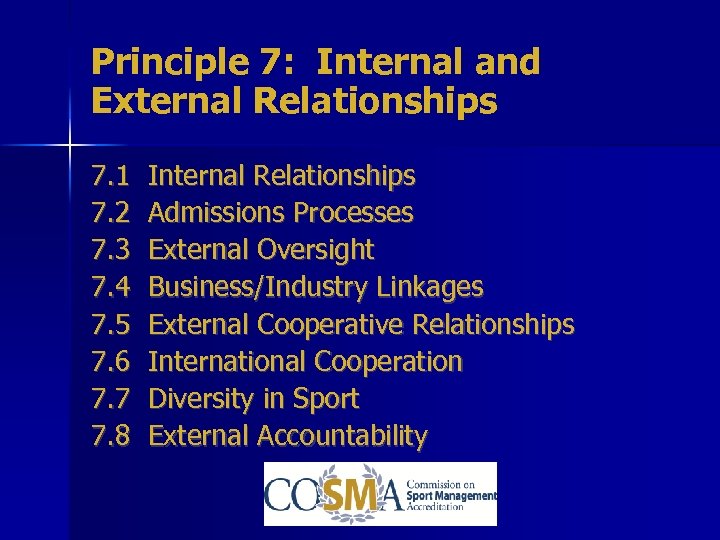
Principle 7: Internal and External Relationships 7. 1 7. 2 7. 3 7. 4 7. 5 7. 6 7. 7 7. 8 Internal Relationships Admissions Processes External Oversight Business/Industry Linkages External Cooperative Relationships International Cooperation Diversity in Sport External Accountability

Quiz #5 Are internships required by COSMA? a) b) c) d) Yes No Only for big institutions Only if you have enough faculty
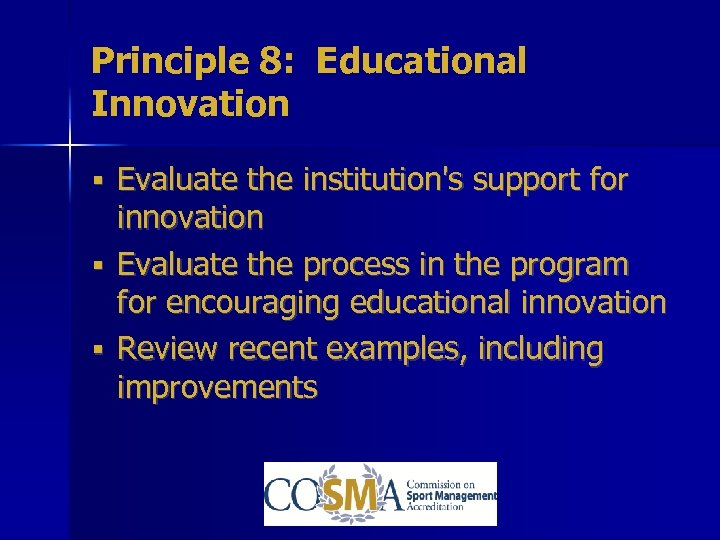
Principle 8: Educational Innovation § Evaluate the institution's support for innovation § Evaluate the process in the program for encouraging educational innovation § Review recent examples, including improvements

On-site Materials Course syllabi Institutional catalog Copy of last regional accreditation self-study report and findings Faculty member vitae Faculty handbook O/A Plan Summary of realized outcomes

Exit Interview Who? Up to the department to determine – usually the campus coordinator, chair, and faculty Review program strengths Review areas that partially meet the principles Review areas that do not meet the principles Answer questions, but do not comment on accreditation status Make suggestions for how the program can remedy deficient areas Encourage the campus coordinator to talk to COSMA
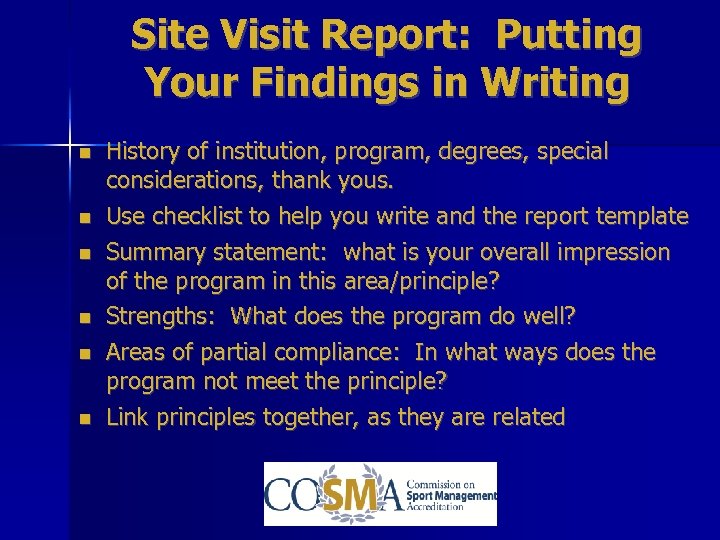
Site Visit Report: Putting Your Findings in Writing History of institution, program, degrees, special considerations, thank yous. Use checklist to help you write and the report template Summary statement: what is your overall impression of the program in this area/principle? Strengths: What does the program do well? Areas of partial compliance: In what ways does the program not meet the principle? Link principles together, as they are related
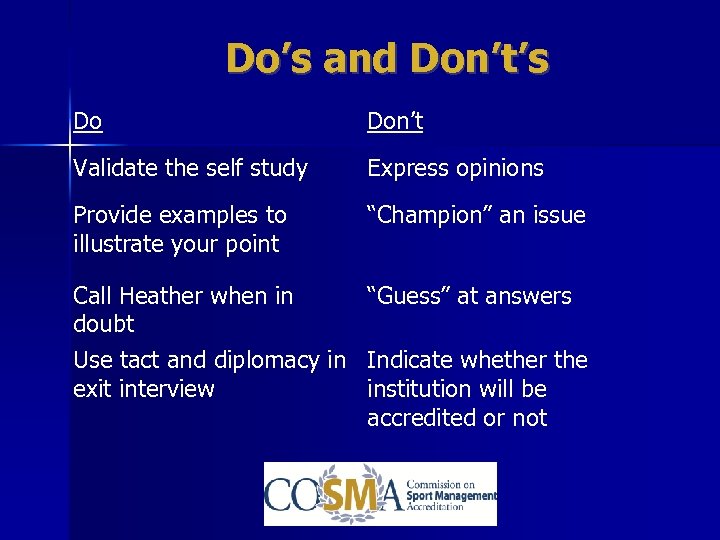
Do’s and Don’t’s Do Validate the self study Don’t Provide examples to illustrate your point “Champion” an issue Express opinions Call Heather when in “Guess” at answers doubt Use tact and diplomacy in Indicate whether the exit interview institution will be accredited or not
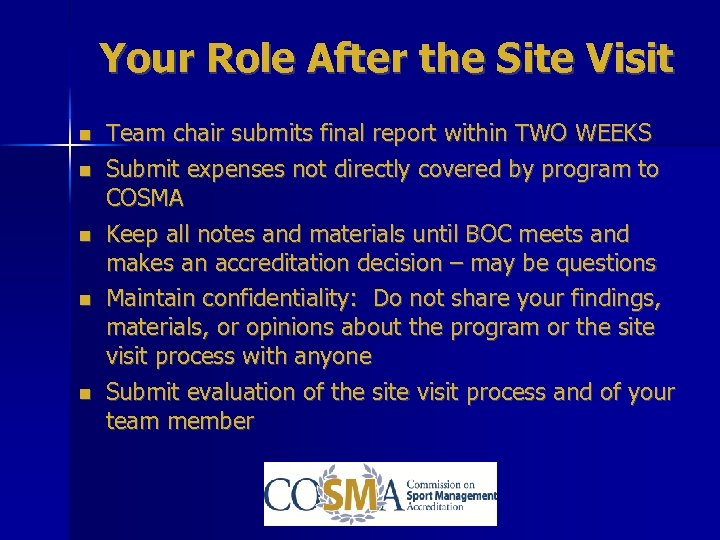
Your Role After the Site Visit Team chair submits final report within TWO WEEKS Submit expenses not directly covered by program to COSMA Keep all notes and materials until BOC meets and makes an accreditation decision – may be questions Maintain confidentiality: Do not share your findings, materials, or opinions about the program or the site visit process with anyone Submit evaluation of the site visit process and of your team member

Evaluation of the Site Team’s Visit Fill out and submit evaluation of your experience Site team members evaluate each other All comments kept confidential Questions include: Professional behavior of the team Anything overlooked by the team Strengths and/or limitations of any team member
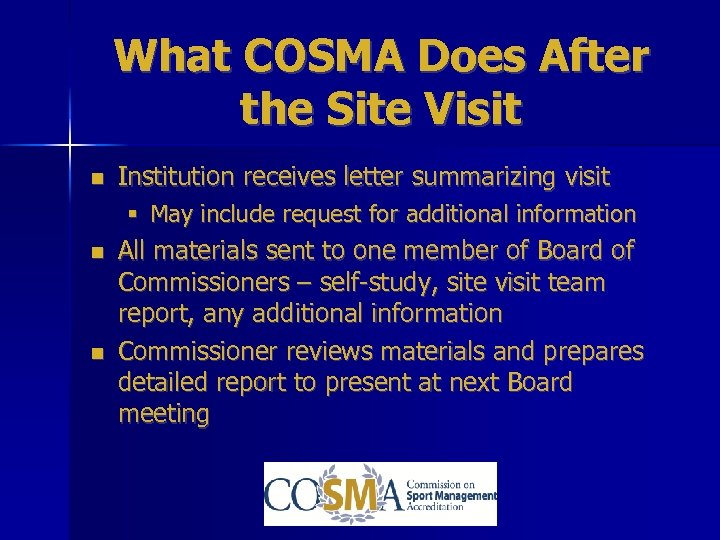
What COSMA Does After the Site Visit Institution receives letter summarizing visit § May include request for additional information All materials sent to one member of Board of Commissioners – self-study, site visit team report, any additional information Commissioner reviews materials and prepares detailed report to present at next Board meeting

Accreditation Decision Accredited with Notes Accredited with Observations Accreditation Deferred Accreditation Denied
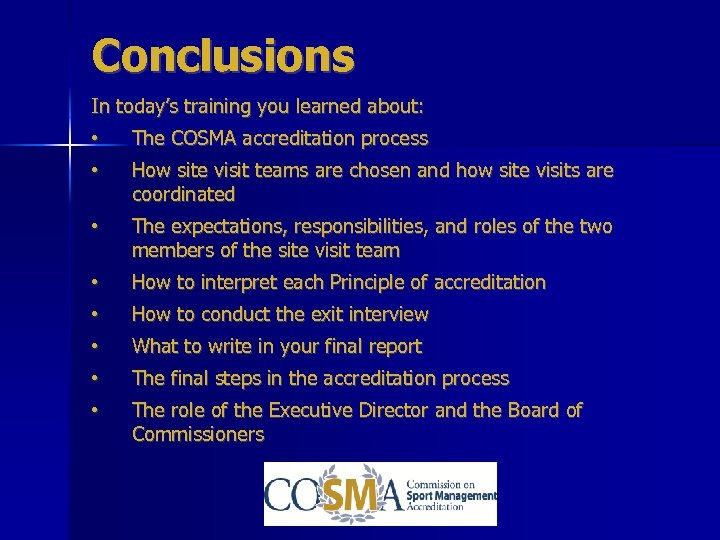
Conclusions In today’s training you learned about: • The COSMA accreditation process • How site visit teams are chosen and how site visits are coordinated • The expectations, responsibilities, and roles of the two members of the site visit team • How to interpret each Principle of accreditation • How to conduct the exit interview • What to write in your final report • The final steps in the accreditation process • The role of the Executive Director and the Board of Commissioners
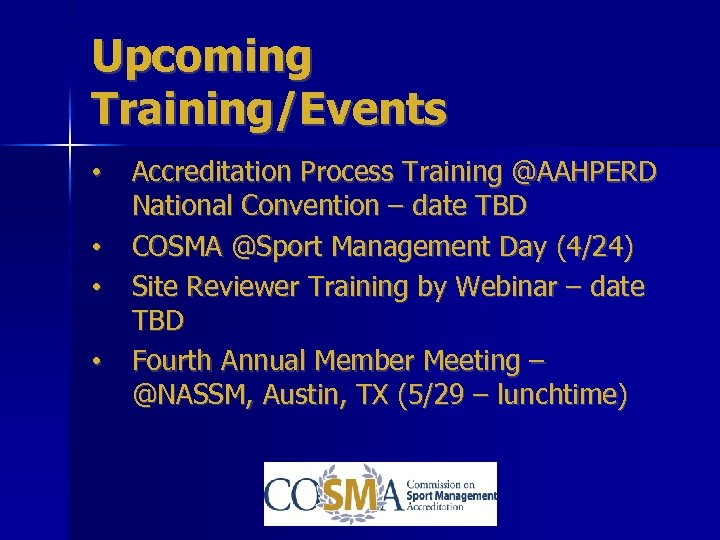
Upcoming Training/Events • • Accreditation Process Training @AAHPERD National Convention – date TBD COSMA @Sport Management Day (4/24) Site Reviewer Training by Webinar – date TBD Fourth Annual Member Meeting – @NASSM, Austin, TX (5/29 – lunchtime)
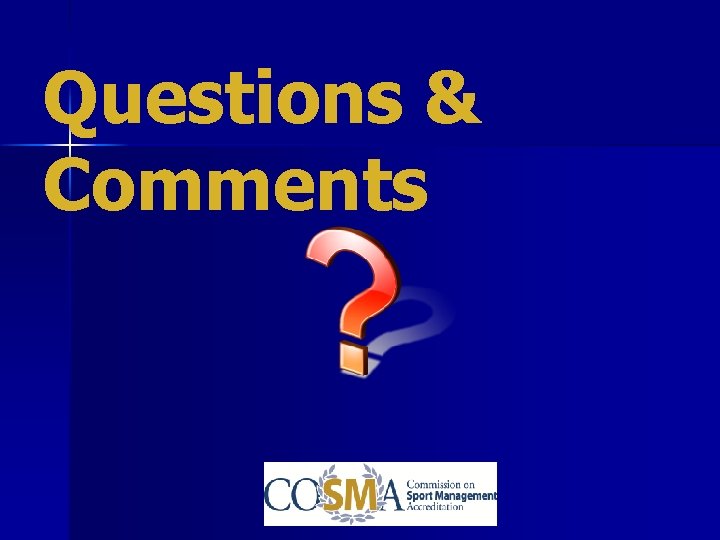
Questions & Comments
8e3fc98ab9ecd61ba807f5c4c197faf4.ppt